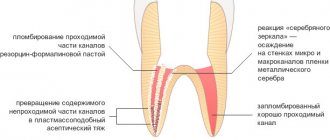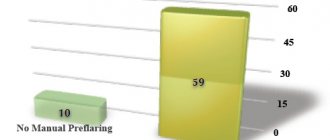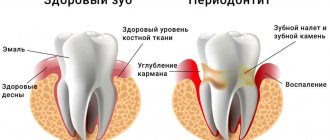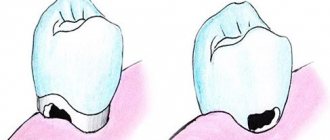Probably one of the most terrible pains a person can experience is toothache. When a tooth hurts, it is almost impossible to endure, and then even the most ardent dentist-hater goes to “surrender” to the doctor. But not everyone knows why teeth hurt and how to avoid these unpleasant sensations. Together with the dentist-therapist of the StilDent clinic, Elena Gennadievna ZIBNITSKAYA, we will look at the most common causes of toothache.
The most common causes of toothache are caries, pulpitis, periodontitis and pericoronitis.
Caries
This is a disease of the hard tissues of the tooth, leading to the destruction of enamel and dentin. First of all, caries affects the natural depressions on the teeth (fissures), as well as areas where plaque accumulates in large quantities - these are the interdental spaces and the gingival area. With caries, the hard tissues of the tooth demineralize and soften, and subsequently a defect in the form of a cavity forms on the tooth.
Caries has several stages, the process can be initial, superficial, medium and deep. At first, caries is almost asymptomatic - the main inconvenience that a person experiences is associated with food getting stuck in carious cavities. Another symptom of caries, which is usually not paid much attention to, is short-term pain from chemical, mechanical, and temperature irritants. Simply put, damaged enamel no longer protects the tooth from the effects of hot tea or ice water or from mechanical stress, and at this moment we experience pain. But because it only lasts a few seconds, we usually don't take it seriously.
When the process reaches the last stage - deep caries, the unpleasant sensations become difficult to ignore. With deep caries, the patient experiences pain when food and liquid enter the damaged area, pain when brushing teeth (irritation from paste and brushes), pain from any external irritants, temperature, chemical, mechanical. Once the irritant is removed, the pain subsides until the next episode. At this stage, the quality of life is already significantly reduced. But if a person continues to stubbornly endure and does not go to the doctor, the nerve of the tooth (pulp) is gradually involved in the inflammatory process, and pulpitis begins.
General recommendations
Regardless of the chosen method of getting rid of toothache, you should follow simple rules:
- Brush your teeth thoroughly with toothpaste and use dental floss. Inflammation could occur due to food stuck between the teeth, removing which can provide tangible relief.
- Try to eat only liquid or soft foods. Excessive pressure on the disturbing tooth will increase the pain syndrome, and the entry of food particles into carious areas will lead to the active development of the inflammatory process.
- The tooth should not be heated. Increased blood circulation will irritate the nerve endings, which will increase the pain. In addition, heat will increase suppuration and other complications.
- Try to distract yourself and not think about the symptom. You can concentrate on work, hobbies or watch a TV series.
Important! Don't give up brushing your teeth. Otherwise, this will provoke active growth of pathogenic microflora, which will aggravate inflammation and increase pain.
Painkillers
Painkillers that are always in your home medicine cabinet effectively relieve pain:
- Analgin is an inexpensive drug that does not require a prescription. The main remedy for getting rid of aching toothache. You cannot apply the tablet to a sore tooth, as analgin eats away the enamel.
Advice. Soak a cotton swab in Valocordin or dip it in crushed Validol. Apply the swab to the painful tooth for 15 minutes.
- Spasmalgon is a stronger analgesic. A single dose should not exceed 2 tablets, and a daily dose should not exceed 6.
These medications should not be taken by pregnant women, nursing young mothers, or children. Taking such medications is incompatible with alcohol. Read the instructions carefully, as there are serious contraindications for disorders of the liver, circulatory system and kidneys.
- Paracetamol is effective for moderate pain. In small doses it has the least negative effect on the body and can be used to help a child get rid of toothache.
Attention! Always read the instructions for medications carefully and follow the dosage to avoid side effects.
Remember that tablets as a way to get rid of toothache do not cure, but only temporarily relieve pain.
Separately, we should highlight nonsteroidal drugs (NSAIDs), which, in addition to getting rid of an unpleasant symptom, reduce inflammation. They are usually prescribed by a doctor after diagnosis.
- Ketanov is a powerful pain reliever when you need to get rid of dental nerve pain. The drug is very toxic, so it is taken only as a last resort, when nothing else has helped. The positive effect lasts 8-10 hours.
- Ibuprofen (Nurofen) can be taken per day no more than 5 tablets at 4-hour intervals. It should not be used by people with hypertension, gastrointestinal diseases, or hearing impairment.
Folk remedies
An effective way to get rid of toothache without pills is folk remedies. They are less toxic, have a gentle effect on the body, but are less effective.
Bactericidal, analgesic natural remedies are:
- Carnation. A thick mixture of half a teaspoon of water and crushed seasoning is applied to the aching tooth for 15-20 minutes.
- Propolis. Chew a small piece the size of a pea until soft and apply to the tooth for 20 minutes.
- Cinnamon. Make a mixture of cinnamon powder and half a teaspoon of honey, then apply a tampon soaked in the mixture to the inflamed area. If you take a cinnamon stick instead of powder, then you need to grate it on a fine grater.
- Onion and garlic. Grind a quarter of an onion and 2 cloves of garlic into a pulp using a fine grater or blender. Add 1/4 tablespoon of salt to the resulting mixture. Dip a cotton-gauze swab into a homogeneous mass and apply it to the inflamed area. Repeat no more than 4 times a day. More frequent use may cause burns to the mucous membrane.
- Plantain. This useful medicinal plant helps get rid of toothache, although it can only be found in the summer. Take a few leaves, wash and dry thoroughly. Apply to the inflamed area and chew until the juice is released. It will not work immediately, but over time the pain will subside.
A striking example of choosing traditional methods to get rid of toothache is pregnancy and lactation. Taking medications at this time is extremely undesirable, requires special caution and can only be done after permission from a doctor. Self-medication is dangerous for the life of the child and the expectant mother
On a note! St. John's wort should not be used in any form during pregnancy! This herb may be toxic to your child.
Rinse
The simplest means to quickly get rid of toothache are rinsing solutions. The ingredients can be found in every home:
- Soda. The simplest but most effective way. A teaspoon of baking soda per glass of warm water. Rinse for 5-10 minutes. If you add a little salt, it will enhance the disinfecting effect.
- Iodine, salt and soda. Add one teaspoon each of salt and soda, two drops of iodine and one drop of alcohol to a glass of warm water. Rinse three times a day.
- Vodka. Place one glass of vodka in your mouth and gargle for several minutes.
- Mint, lemon balm or sage. Pour two tablespoons of dry leaves with a glass of boiling water and let it brew for 25-30 minutes. Rinse with warm (not hot) infusion 5 times a day.
- Oak bark. Place two tablespoons of the product into boiling water and leave to simmer for half an hour. Thoroughly strain the broth through several layers of gauze. Rinse with a cooled solution up to 5 times a day.
Essential oils
This is another effective method known since ancient times. Essential oils from:
- carnations;
- coriander;
- tea tree;
- mint;
- fir trees
The method of application is the same for all oils:
- two or three drops of oil are applied to a cotton-gauze swab;
- Place a tampon on the painful area.
Make sure that the tooth is treated from all sides, including carious holes.
Note! Do not hold the tampon with essential oil for more than 5 minutes. Otherwise, you may damage the oral mucosa.
Massage
In addition to taking medications and rinsing, you can add massage. You can move the gum around the inflamed tooth with light massaging movements. This method helps some, however, it is safer to stimulate other points on the body that are responsible for toothache.
It is generally accepted that circular massage movements of the earlobe and temple from the side of the diseased tooth can temporarily relieve pain. To obtain the desired analgesic effect, the duration of such a massage should be at least 5 minutes.
Another point responsible for toothache is the area between the thumb and index finger. Moreover, you need to massage the hand opposite to the side of the diseased tooth. That is, if there is pain on the left side, we massage the right hand and vice versa.
There are many quick ways to get rid of toothache at night, while visiting, on a business trip or while on vacation without visiting a doctor. It is important not to forget that none of them, except a visit to the dentist, will eliminate the problem, but will only remove an unpleasant symptom. Temporary apparent relief can lead to serious complications. Don't delay your visit to the doctor to have a beautiful smile and good health.
Pulpitis
This is an inflammation of the pulp (nerve) of the tooth, the process is usually accompanied by acute pain. Pulpitis occurs as a reaction to constant exposure to irritants that enter the pulp through a carious cavity, as well as due to the influence of microorganisms and toxins on the nerve of the tooth. Irritation of the pulp leads to a change in blood flow, which provokes increased pressure on the nerve fibers.
At the initial stage, pulpitis manifests itself as mild pain, which goes away when the irritant is removed. At this stage, the inflammation goes away on its own if the irritant is removed - that is, caries is cured and the tooth is filled, isolating the pulp from external influences.
If you do nothing, the inflammation gradually intensifies and the pain increases. The stage of acute pulpitis begins, irreversible changes occur in the pulp. Pain is easily caused by any irritant. The “don’t eat, don’t drink, keep your mouth closed” option doesn’t save you from pain. Very often, toothache worsens at night.
Pain in acute pulpitis can be very different:
- Sharp or blunt
- Pulsating or constant
- Localized or spilled
- Short or long term
If you continue to ignore your condition and do not consult a dentist, then the next stage is complications that are likely to develop with acute pulpitis, including purulent pulpitis.
Inflammation of the bone tissue of the tooth
The inflammatory process is the primary source of osteitis in the bone tissue of the jaw; if proper treatment is not provided in time, it will develop into periostitis (the periosteum becomes inflamed), osteomyelitis (the bone marrow becomes inflamed). With osteitis, pain is felt, the affected area swells, difficulties arise in chewing food, and the entire jaw gradually begins to ache. The cause of symptoms of osteitis is:
- Received traumatic actions, blows, bruises, jaw fracture;
- Surgical complication;
- tuberculosis and syphilis;
Treatment of osteitis occurs through surgery with the use of antibiotics and immunostimulating medications. Decaying teeth harbor bacteria and must be removed to prevent further inflammation. Patients with tuberculosis or syphilis first cure the underlying disease, then proceed to eliminate osteitis.
The slightest suspicion of pain in the bone tissue in the oral cavity is a reason to consult a doctor. Treatment of osteitis started in the first stage will make it possible to save teeth and protect against painful complications. Successful treatment depends on correct implementation of the dentist’s recommendations and careful oral care.
Chronic pulpitis
In the most patient patients, acute pulpitis can become chronic. The pain becomes less acute and constant, sometimes subsides for a long time. If the carious cavity is difficult to access by irritants, chronic pulpitis can be almost painless.
Symptoms of chronic pulpitis
- Pain in the cold
- Pain when eating hot food
- Pain during temperature changes (for example, when you leave the house on a cold street)
- Prolonged aching pain if the carious cavity is clogged with food debris
Chronic pulpitis can worsen at any time and give you all the unforgettable sensations of acute pulpitis.
If chronic pulpitis is not treated, it can develop into periodontitis.
Acute periodontitis
Periodontitis is an inflammatory process in periodontal (periodontal) tissues in the area of the apex of the tooth root. Often, inflammation involves the cementum and dentin of the tooth root, as well as the alveolar bone. Periodontitis in most cases occurs due to damage to the pulp, that is, pulpitis.
Symptoms
- The pain is constant, throbbing, with clear localization
- The pain intensifies from any touch to the tooth, including when chewing
- Pain may spread to part of the face
- Headache
- General weakness
- Temperature increase
- Cheek swelling
- Pain in the gum, redness and swelling in it
- Submandibular and chin lymph nodes are enlarged
- Possible discharge of pus from the root canal
Inflammation of a wisdom tooth
The location of this tooth in the oral cavity is sometimes difficult to reach for a doctor and is therefore considered the most difficult to treat. The wisdom tooth begins to erupt closer to the age of eighteen, which is why it received the name “comes with wisdom.” When it erupts, painful discomfort is felt, the reason is the absence of milk teeth in this place previously, so the incisor, growing, cuts through the gum. Swelling of the cheek and inflammation of the gums begins, which covers the area of the wisdom tooth; various symptoms may also appear, the lymph nodes become inflamed, swallowing becomes difficult, and the temperature rises.
A slight swelling can be considered normal, and the cause of the inflammatory process can be several factors:
- The wisdom tooth is looking for a place to come out, but not finding it creates inflammation in the gum and nerve;
- When the gums come out, there is not enough free space for normal growth, it begins to put pressure on the teeth in the neighborhood, which causes inflammation;
- The location of the growth of wisdom teeth depends on the structure of the oral cavity; if the shape is irregular, inflammation often occurs and cysts form.
To determine the presence of an inflammatory process in a wisdom tooth, you will need an x-ray; there are characteristic signs of inflammation:
- Sensation of unpleasant taste;
- Swelling of the gums around the tooth;
- The resulting pus spreads in the oral cavity, forming a pungent odor;
- When a wisdom tooth grows, the pain radiates to the temple or ear.
In this case, consulting a doctor is mandatory. If proper treatment is not started on time, it can lead to severe pain and many complications, the formation of purulent abscesses and phlegmons, which are subsequently resolved surgically.
Today, more and more dentists are of the opinion that the wisdom tooth does not need to be treated, but should simply be removed, because it's more trouble than it's worth. The complexity of treating its roots is determined by its location, and the doctor will make a decision in each individual case: to treat or remove a wisdom tooth.
Chronic periodontitis
Chronic periodontitis sometimes develops asymptomatically, or acute periodontitis can progress to this stage. Chronic periodontitis develops when the pulp dies, and favorable conditions are created in the tooth for the development of microorganisms. Sometimes chronic periodontitis can appear after a tooth injury.
Symptoms
- Changing the color of tooth enamel
- The presence of a fistula on the gum
- Painful sensations when chewing solid food
Chronic periodontitis can have many very serious complications: granuloma, root cyst, pathological fracture of the lower jaw, periapical abscess, phlegmon and others.
Causes
The cause of pain in the teeth can be both dental and non-dental reasons.
Dental include:
- caries or its more severe form pulpitis;
- gingivitis or periodontitis, when the gums or tissue around the tooth root become inflamed;
- periostitis, in which rotting of the alveolar processes occurs in the upper or lower jaw;
- postoperative complications or errors during filling.
Also, toothache can be a concomitant symptom of other diseases, for example:
- migraine and other types of headaches;
- maxillofacial neuralgia, including inflammation of the trigeminal nerve;
- diseases of the ENT organs;
- oncology;
- disruptions in the functioning of the cardiovascular system.
Attention! Only a dentist can determine the exact diagnosis. At home, you can only try to get rid of toothache, easing your condition before visiting a doctor.
Pericoronitis
This is difficult eruption of wisdom teeth (eights). When a tooth cannot erupt normally, inflammation of the surrounding soft tissue and periosteum behind the dental socket begins. Inflamed gums are constantly injured when chewing, which further aggravates the process.
The inflammatory process can gradually lead to the development of purulent pericoronitis.
Symptoms:
- Constant pain that gets worse when chewing
- Pain radiates to the ear and temporal region
- Pain when opening the mouth
- Enlargement and tenderness in the submandibular lymph nodes
- Sharp pain when pressing on the gums, purulent discharge is possible
- Increased body temperature
In the future, the pain continues to intensify and the body temperature rises. The patient's health deteriorates significantly, and retromolar periostitis may develop.
Main features
- Pain
In each case it can manifest itself differently. Sometimes it is pain when biting, sometimes it is continuous. It may get worse at night and subside with meals. It can radiate to the temple, ear, even nose. Being whiny or harsh.
- Redness
It may or may not be visible. This is a symptom that is more often detected by a doctor.
- Edema
Any inflammation is accompanied by swelling, but we cannot always determine this.
- Temperature increase
This doesn’t always happen, but fever is a sign of inflammation, so in this case you definitely shouldn’t put off going to the dentist.
- Tumor
This is also a dangerous signal; you need to see a doctor urgently.
If a tooth is inflamed and hurts, temporary measures will not help; you need a full diagnosis and treatment in a clinic. The alternative is tooth loss due to an advanced process.










